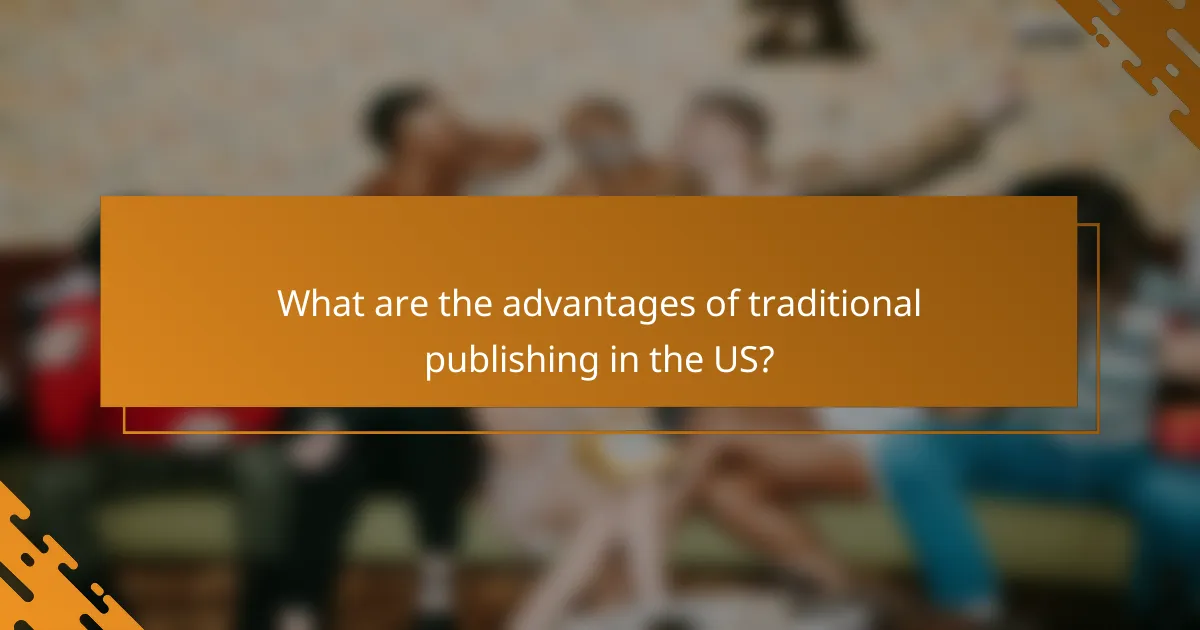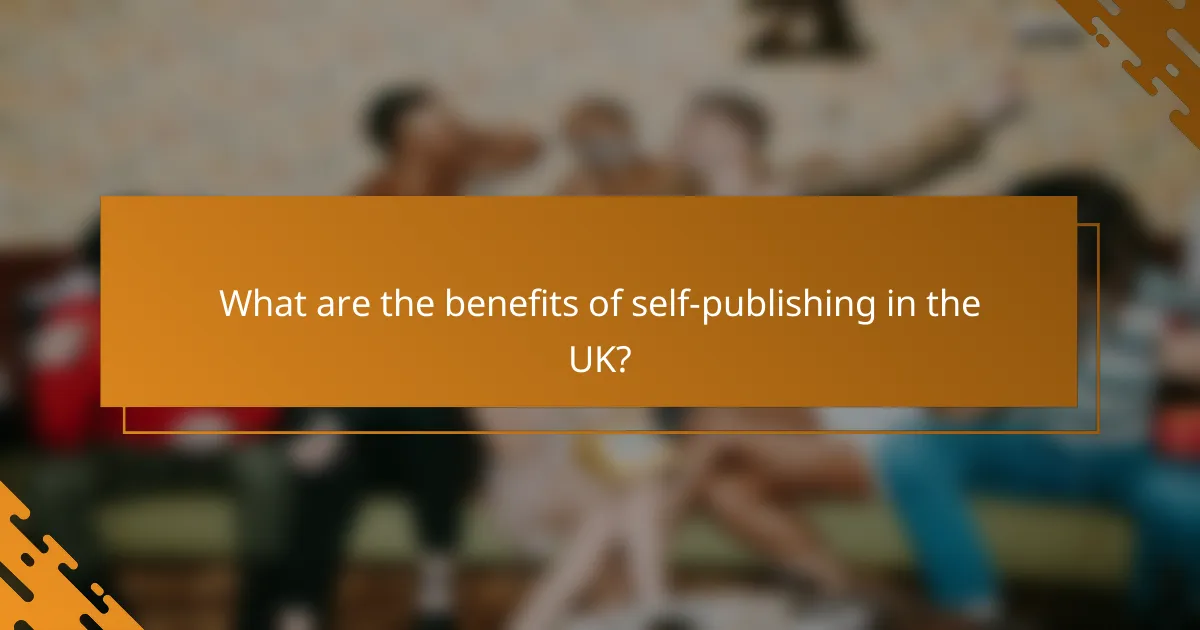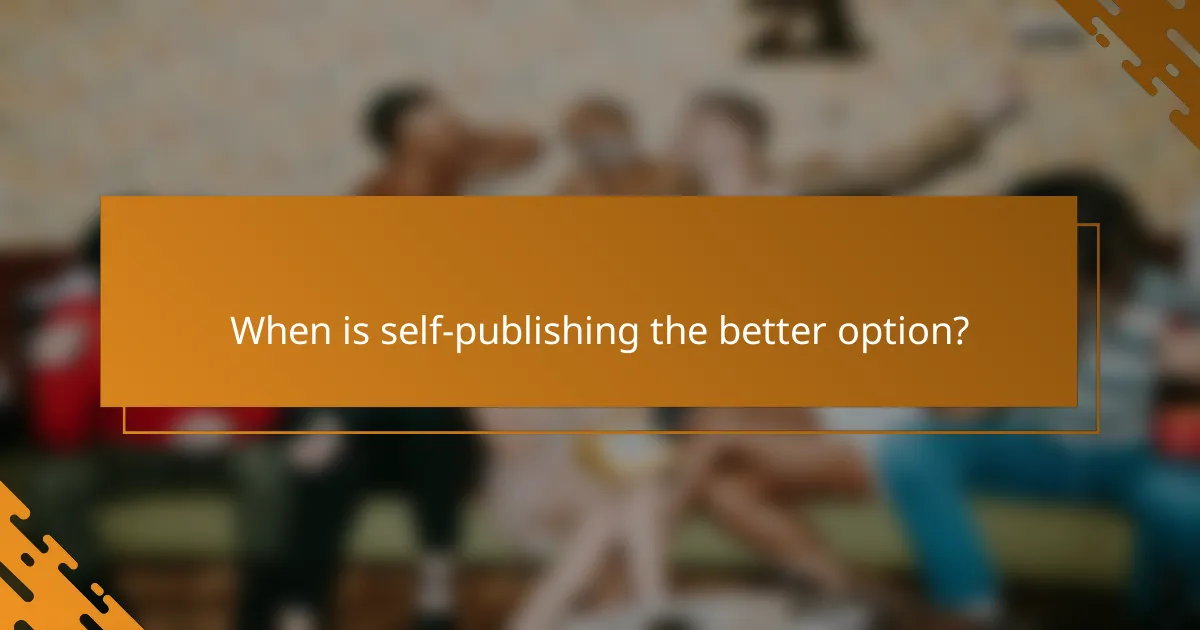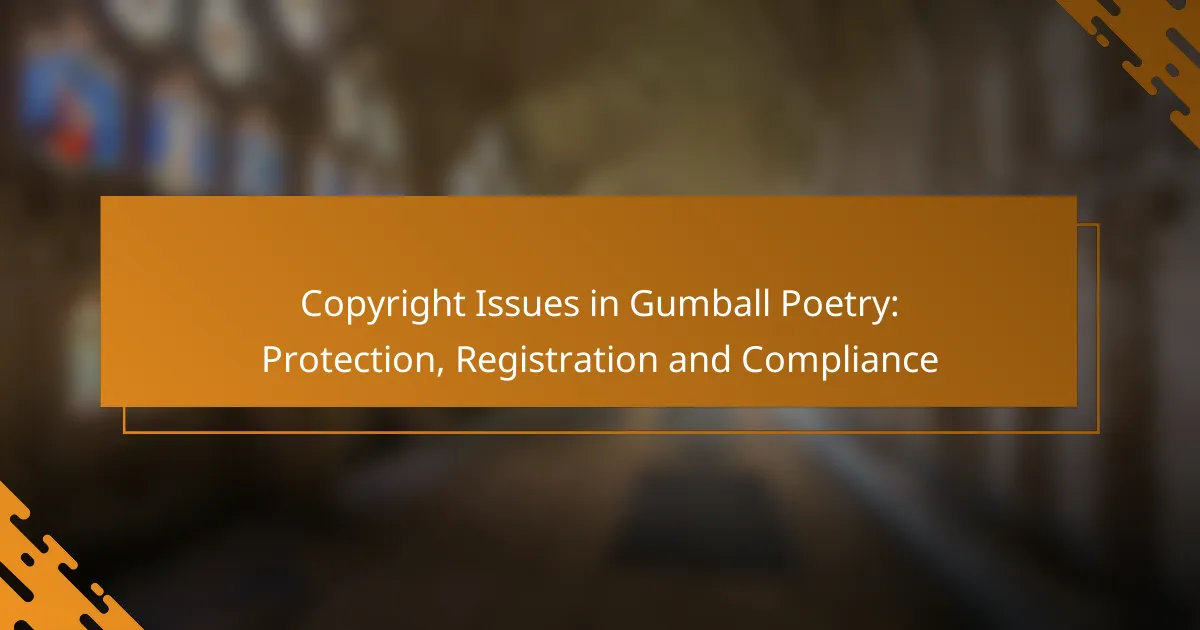Choosing between traditional publishing and self-publishing involves weighing various factors, including control, financial rewards, and support. Traditional publishing provides authors with professional editing, established distribution, and marketing resources, enhancing their book’s visibility. In contrast, self-publishing offers greater creative freedom and quicker access to audiences, making it an appealing option for those seeking to retain control over their work.

What are the advantages of traditional publishing in the US?
Traditional publishing in the US offers several key advantages, including established distribution networks, professional editing and design, and access to marketing resources. These benefits can significantly enhance a book’s visibility and credibility in a competitive market.
Established distribution networks
Traditional publishers have well-established distribution channels that can place books in major retailers, libraries, and online platforms. This extensive network allows for broader reach and accessibility, making it easier for readers to find and purchase books.
Authors benefit from the publisher’s relationships with distributors and retailers, which can lead to better shelf placement and visibility. For example, a traditionally published book may appear in prominent displays in bookstores, increasing its chances of sales.
Professional editing and design
One of the significant advantages of traditional publishing is access to professional editing and design services. Publishers employ experienced editors who refine manuscripts, ensuring clarity, coherence, and overall quality.
Additionally, traditional publishers provide professional cover design and formatting, which are crucial for attracting readers. A well-designed cover can significantly impact a book’s marketability, making it stand out in a crowded marketplace.
Access to marketing resources
Traditional publishers typically have dedicated marketing teams that create and execute promotional campaigns for their books. This includes organizing book tours, sending out advance reader copies, and leveraging social media platforms to generate buzz.
Authors can benefit from these resources without bearing the financial burden of marketing expenses. For instance, a publisher may allocate a budget for advertising in industry magazines or online platforms, increasing the book’s exposure to potential readers.

What are the benefits of self-publishing in the UK?
Self-publishing in the UK offers authors greater financial rewards and creative freedom compared to traditional publishing. It allows writers to retain control over their work and reach their audience more quickly.
Higher royalty rates
One of the most significant benefits of self-publishing is the potential for higher royalty rates. Authors can earn anywhere from 60% to 80% of the sales price, compared to the 10% to 15% typically offered by traditional publishers. This means that for every book sold, self-published authors keep a larger share of the profits.
For example, if a self-published book sells for £10, the author could earn £6 to £8, while a traditionally published author might only see £1 to £1.50. This financial incentive can make self-publishing a more lucrative option for many writers.
Creative control over content
Self-publishing grants authors complete creative control over their content. Writers can make decisions about the book’s cover design, formatting, and even the content itself without needing approval from a publisher. This autonomy allows authors to express their vision fully and cater to their target audience’s preferences.
Additionally, self-publishing enables authors to revise and update their work as needed, keeping it relevant and aligned with reader expectations. This flexibility is often restricted in traditional publishing, where changes can be a lengthy process.
Faster publication timelines
Self-publishing typically results in much faster publication timelines compared to traditional routes. Authors can often publish their work within a few weeks or months, while traditional publishing can take a year or more due to lengthy editorial processes and marketing strategies.
This speed allows authors to respond quickly to market trends or reader feedback, making it easier to capitalize on timely topics or popular genres. For writers looking to establish a presence or build an audience rapidly, self-publishing is a compelling option.

When should you choose traditional publishing?
Traditional publishing is often the best choice for authors seeking industry expertise, access to major retailers, and comprehensive support throughout the publishing process. It typically involves a publisher handling the logistics, marketing, and distribution of the book, allowing authors to focus on writing.
For genre-specific expertise
Choosing traditional publishing can be beneficial when your book fits into a specific genre that publishers have experience with. Publishers often have established connections and knowledge about market trends, which can enhance your book’s chances of success. For instance, a publisher specializing in romance novels will understand the nuances of that market better than a self-published author might.
Additionally, traditional publishers can provide valuable insights into what elements resonate with readers in your genre, helping to refine your manuscript before it hits the shelves.
When targeting major bookstores
If your goal is to get your book into major bookstores, traditional publishing is usually the way to go. Established publishers have existing relationships with retailers, making it easier for your book to be stocked on shelves. Self-published books often face challenges in gaining shelf space in prominent stores.
Moreover, traditional publishers can manage the logistics of distribution and returns, which are critical factors for bookstores when deciding which titles to carry.
For extensive author support
Traditional publishing typically offers extensive support for authors, including editing, cover design, and marketing. This support can be invaluable, especially for first-time authors who may not have experience navigating the publishing landscape. Publishers often employ teams of professionals dedicated to ensuring the book’s success.
However, it’s essential to consider that this support often comes at the cost of a larger share of royalties. Weighing the benefits of professional assistance against potential earnings is crucial when deciding on traditional publishing.

When is self-publishing the better option?
Self-publishing is often the better choice when authors want greater control over their work and faster access to the market. It allows for flexibility in pricing, distribution, and marketing strategies, making it suitable for various situations.
For niche markets
Self-publishing is particularly advantageous for authors targeting niche markets. Traditional publishers may overlook specialized topics due to limited audience size, but self-publishing enables authors to reach specific groups effectively. For instance, an author writing about a unique hobby can directly connect with enthusiasts through online platforms.
By using targeted marketing strategies, such as social media campaigns or niche-specific forums, authors can build a loyal readership without the constraints of a traditional publishing model.
When prioritizing speed
Self-publishing allows authors to publish their work quickly, often within weeks or even days. In contrast, traditional publishing can take months or years due to lengthy submission processes and editorial reviews. This speed is crucial for authors looking to capitalize on current trends or timely topics.
To maximize this advantage, authors should prepare their manuscripts thoroughly and consider using print-on-demand services to streamline the publishing process.
For personal branding
Self-publishing is an effective way to enhance personal branding for authors. By maintaining full control over their content and presentation, authors can create a unique brand identity that resonates with their audience. This approach is particularly beneficial for professionals looking to establish authority in their field.
Authors should focus on consistent messaging across their publications and online presence, utilizing platforms like blogs, social media, and newsletters to engage with readers and build a community around their brand.

What are the costs associated with traditional publishing?
The costs associated with traditional publishing can be significant and vary widely based on several factors, including the publisher and the book’s genre. Authors typically do not pay these costs upfront, as they receive an advance against future royalties, but understanding these expenses is crucial for evaluating the overall financial landscape.
Advance payments
Advance payments are upfront sums that publishers provide to authors before the book is released. These payments can range from a few thousand to several hundred thousand dollars, depending on the author’s track record, the book’s potential, and the publisher’s budget. Authors should consider that this advance is recouped from future royalties, meaning they will not earn additional income until sales surpass this amount.
Marketing expenses
Marketing expenses in traditional publishing are typically covered by the publisher, but the extent of this support can vary. Publishers may allocate budgets for promotional activities, including book tours, advertising, and social media campaigns. Authors should be proactive in discussing marketing strategies with their publishers to ensure adequate promotion of their work.
Distribution fees
Distribution fees are costs incurred when publishers get books into stores and online platforms. These fees can include shipping, warehousing, and retailer discounts, which may be around 40-60% of the book’s retail price. Authors should be aware that these fees impact their royalty calculations, as they are deducted from the sales revenue before royalties are paid out.

What are the costs of self-publishing?
Self-publishing costs can vary widely, typically ranging from a few hundred to several thousand dollars. Key expenses include editing, design, marketing, and distribution, all of which are essential for producing a professional-quality book.
Editing and design services
Editing and design are crucial components of self-publishing that directly impact the quality of your book. Professional editing can cost anywhere from a few hundred to several thousand dollars, depending on the level of service required, such as developmental editing, copyediting, or proofreading.
Design services, including cover design and interior formatting, are equally important. A well-designed cover can significantly influence a reader’s decision to purchase. Expect to pay between $200 and $1,500 for quality design work, depending on the designer’s experience and the complexity of your project.
To keep costs manageable, consider seeking out freelance editors and designers on platforms like Upwork or Fiverr, where you can find a range of prices and styles. Always review portfolios and request samples before committing to ensure the quality meets your expectations.


